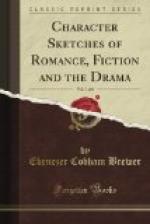BEATRICE CENCI, the Beautiful Parricide (q.v.).
BEATRICE D’ESTE, canonized at Rome.
BEATRICE GIORGINI, an Italian contessa whose parents contract a secret marriage, an unequal match as to birth and fortune, and, dying young, one by violence, leave their child in charge of Betta, a faithful nurse, who takes her to her mother’s mother, an old peasant. At her grandmother’s death she becomes companion to a relative of her father; marries don Leonardo, her father’s cousin and one of the witnesses to the secret marriage, and uses him to prove her legitimacy and his own treachery.—Mary Agnes Tincker, Two Coronets (1889).
BEAU BRUMMEL, George Bryan Brummel, son of a London pastry-cook, who became the fashion at the court of George III. and reigning favorite of the Prince of Wales. His story has been made the foundation of a brilliant American play by Clyde Fitch, in which Richard Mansfield takes the part of Brummel (1890).
BEAU CLARK, a billiard-maker at the beginning of the nineteenth century. He was called “The Bean,” assumed the name of Beauelerc, and paid his addresses to a protegee of lord Fife.
BEAU FIELDING, called “Handsome Fielding” by Charles II., by a play on his name, which was Hendrome Fielding. He died in Scotland Yard.
BEAU HEWITT was the original of sir George Etherege’s “Sir Fopling Flutter,” in the comedy called The Man of Mode or Sir Fopling Flutter (1676).
BEAU NASH, Richard Nash, called also “King of Bath;” a Welsh gentleman, who for fifteen years managed the bath-rooms of Bath, and conducted the balls with unparalleled splendor and decorum. In his old age he sank into poverty (1674-1761).
BEAU D’ORSAY (Le), father of count d’Orsay, whom Byron calls “Jeune Cupidon.”
BEAU SEANT, the Templars’ banner, half white and half black; the white signified that the Templars were good to Christians, the black, that they were evil to infidels.
BEAU TIBBS, in Goldsmith’s Citizen of the World, a dandy noted for his finery, vanity, and poverty.
BEAUCLERK, Henry I. king of England (1068, 1100-1135).
BEAUFORT, the lover of Maria Wilding, whom he ultimately
marries.—A.
Murphy, The Citizen (a farce).
BEAUJEU (Mons. le chevalier de), keeper of a gambling-house to which Dalgarno takes Nigel.—Sir W. Scott, Fortunes of Nigel (time, James I.).
Beaujeu (Mons. le comte de), a French officer in the army of the Chevalier Charles Edward, the Pretender.—Sir W. Scott, Waverley (time, George II.).
BEAUMAINS ("big hands"), a nickname which sir Key (Arthur’s steward) gave to Gareth when he was kitchen drudge in the palace. “He had the largest hands that ever man saw.” Gareth was the son of king Lot and Margawse (king Arthur’s sister). His brothers were sir Gaw’ain, sir Agravain, and sir Gaheris. Mordred was his half-brother.—Sir T. Malory, History of Prince Arthur, i. 120 (1470).




